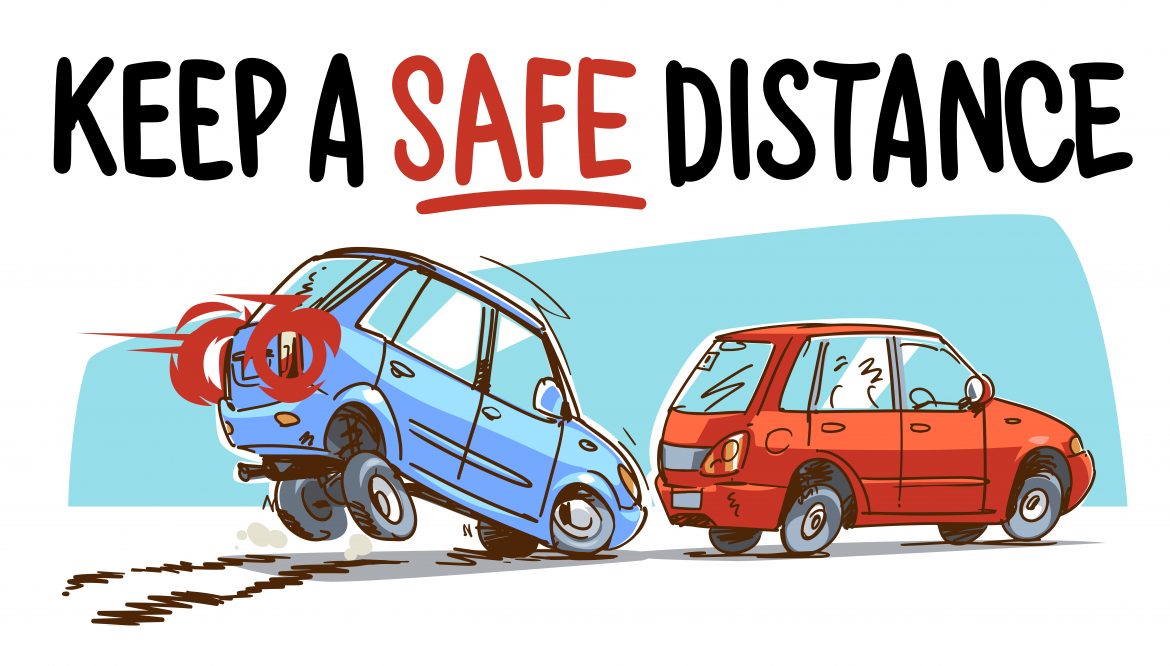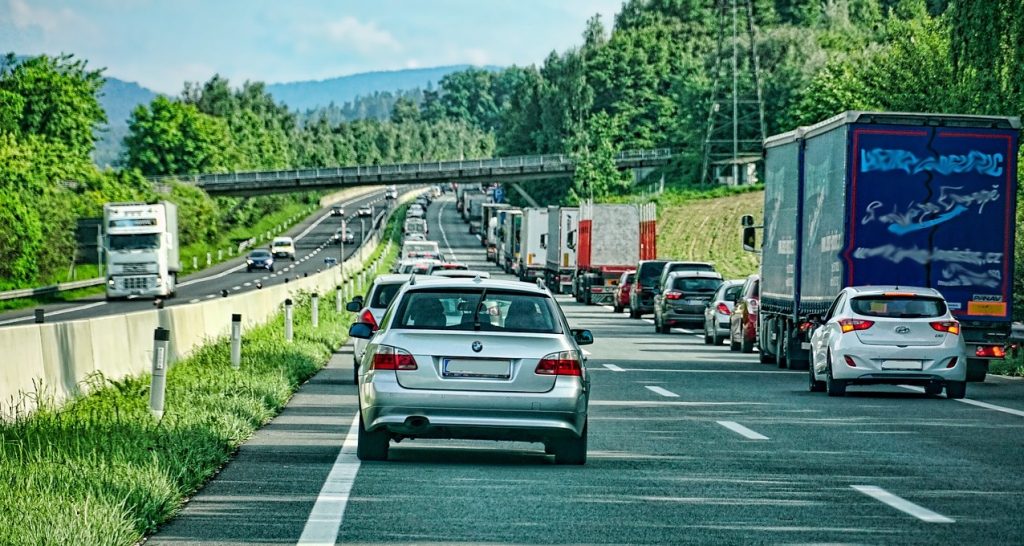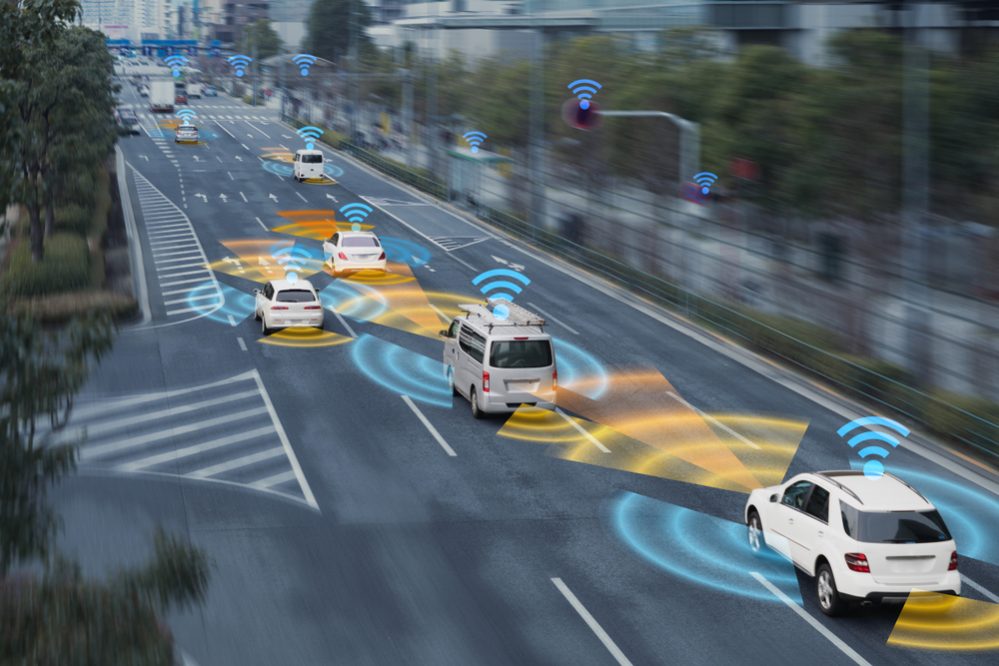While everyone on the road should (in theory) have a valid driving license, unfortunately, not everybody has the same level of skill behind the wheel. Nobody wants to be involved in a crash, so let’s look at one important aspect of driving – what is a safe following distance?
Understanding “stopping distance”
First, let’s talk about the concept of “stopping distance”.
Stopping distance refers to how far it takes you to bring the car to a full stop in an emergency, and it is determined by two factors: your reaction distance and your braking distance.
Reaction distance and braking distance
Your reaction distance is how far your car travels between something happening on the road up ahead and you reacting to it.
Since nobody has perfect reactions, there will always be a certain amount of time, even just a split second, between the moment when something happens and when you hit the brakes.
The reaction time depends on several factors, including age and experience. For most people, it is in the range of 0.2 seconds to 2 seconds.
If you are traveling slowly, the distance you cover will be minimal – but if you are driving at speed, the distance your car travels in just that short moment can be considerable.
Your braking distance is how far your car travels after you hit the brakes before coming to a complete stop.
Again, the faster you are traveling, the longer it will take you to come to a full stop – braking distance is directly proportional to your speed, so if you double your speed, you double your braking distance.
Your total stopping distance is equal to your reaction distance plus your braking distance. So, for example, if something happens ahead and you travel 20ft before you react and then another 20ft before bringing the car to a complete stop, your total stopping distance will be 40ft.
In other words, from the moment something happens up ahead to when you bring the car to a full stop, you will need 40ft.
Working out your stopping distance
There are several ways of working out your stopping distance. One way is to multiply your speed by a certain factor that increases with your speed.
So, for example, at 20mph, you multiply by 2 – giving you a stopping distance of 40ft. For 30mph, you multiply by 2.5, giving you 75ft – and so on, adding 0.5 for every extra 10mph of speed.
However, this is too complicated to think about while you are driving – and anyway, this only tells you the distance you need to come to a complete stop. It doesn’t take into account the fact that the car ahead is also moving.
For these reasons, we need a better way to calculate a safe following distance that doesn’t rely on you doing calculations in your head as you drive.
The two-second rule
The easiest and quickest way to calculate a safe following distance (the safe amount of distance between you and the car ahead of you) is to use the two-second rule.
Basically, the two-second rule states that you should stay a full two seconds behind the car in front of you, whatever speed you are traveling at.
The reason the two-second rule works regardless of your speed is that the faster you travel, the greater the distance you cover in two seconds. This means that as your speed increases, the distance between you and the car ahead also needs to increase to leave the required two-second gap.
The two-second rule also takes into account the fact that the car in front will need a certain distance to come to a stop, which gives you a little extra time.
If you were traveling at 70mph and the car in front suddenly came to a complete stop on the spot, you would probably not be able to stop in time to avoid hitting it.
However, in reality, this can’t happen – unless, for example, the car in front went into the back of a stationary large truck and stopped dead. But even then, the two-second rule would give you a few valuable moments to react and avoid the accident yourself by taking evasive action.
How to calculate the two-second distance
Calculating a two-second gap between you and the car in front is extremely easy – which is why this method of judging distance is so useful and effective.
As you are driving, simply take a point of reference up ahead. It could be anything – a lamppost, a tree or anything else by the side of the road.
When the car in front passes the point of reference, you need to time two seconds and then make sure you don’t pass the point of reference before two seconds are up.
You can try to estimate two seconds in your head just by counting slowly – but a better way if you are not sure you can judge the time accurately is to say “one-one-thousand-two-one-thousand” at a normal speed. This will give you a better approximation of two seconds.
If you find that you pass the point of reference in under two seconds, it means you are too close, and you should drop back a little. If it takes you more than two seconds, you are fine.
The three-second rule
Some experts consider a two-second distance to be the absolute minimum that you should allow but suggest that to be truly safe, you should apply the three-second rule instead. This means you allow an extra one second of distance on top of the two seconds to give yourself an extra margin of safety.
Whenever possible, we would advise following the three-second rule rather than the two-second rule. Being cautious won’t cost you anything since you will still be traveling at the same speed, but it may be the difference between having an accident and avoiding one.
Are there times when the three-second rule doesn’t apply?
There are times when the three-second rule doesn’t apply and when only leaving three seconds of distance between you and the car in front could still be dangerous.
For example, in bad weather, you should consider leaving more than this minimum distance between you and the car in front.
One example would be in moderate rain. In this case, you would be better advised to double the distance and use a “six-second rule”, counting to six before you pass the chosen point of reference.
In very heavy rain, snow or icy conditions, you should leave a nine-second gap – and in these conditions, you should also consider driving much more slowly than would otherwise be the case.
These guidelines are fairly self-evident since driving safely always involves adapting your driving to the conditions – but at least by calculating a six-second or nine-second stopping distance, you are ensuring you have plenty of time to pull up if something unexpected happens.
The following table shows how allowing three- and six-second gaps between you and the car in front translates into the distance there should be between you and the car in front.
The Three-Second Rule Chart
| Three-Second Rule | Safe Interval Should Be | 3 seconds | 6 seconds | |
| Speed | Distance Traveled | For These Conditions | Good | Marginal |
| 25 m.p.h. | 37 ft. per second | 111 ft. | 222 ft. | |
| 35 m.p.h. | 52 ft. per second | 166 ft. | 312 ft. | |
| 45 m.p.h. | 66 ft. per second | 198 ft. | 396 ft. | |
| 55 m.p.h. | 81 ft. per second | 243ft. | 486 ft. | |
| 65 m.p.h. | 96 ft. per second | 288 ft. | 576 ft. | |
| 75 m.p.h. | 111 ft. per second | 333 ft. | 666 ft. | |
| Safe Following Distance in Feet | ||||
Why you shouldn’t tailgate
Tailgating – driving too close to the car ahead of you – is a very dangerous practice, both for the tailgater and the car in front. Unfortunately, many people still do it.
In fact, the likelihood that you will tailgate seems to be at least partly affected by factors including sex as well as the type of car you drive, as this table shows:
| Tailgating | Type Of Vehicle | ||
| Sex Of Driver | Family / Economy Cars | Sports Cars | SUVs |
| Male | 13% | 23% | 18% |
| Female | 13% | 20% | 25% |
If you leave less than the recommended two or three seconds between you and the car you are following, you risk driving into the back of it if it stops suddenly.
Tailgating can also feel very aggressive. If a driver is being followed too closely, it may make him or her feel pressured and even anxious. Anxious, flustered drivers are more prone to mistakes or bad decisions, which could endanger both cars.
Some drivers also react aggressively to tailgaters, in the same way that some people become angry when you invade their personal space. A common reaction to tailgating is to hit the brakes suddenly to flash the brake lights and cause the car behind to brake suddenly as well.
This is obviously a dangerous maneuver since the car behind might not react in time – or the sudden braking could cause a third car further back to run into the tailgater.
Furthermore, tailgating and this kind of sudden braking to warn a tailgater off can easily cause one or both drivers to lose their cool, and this behavior can quickly lead to road rage, more dangerous driving and even a full-blown confrontation.
The advice is clear – don’t tailgate. Make sure you always leave at least two seconds of distance between you and the car in front, or even better, try to leave three. If someone is tailgating you, don’t slam on the brakes. Instead, slow down gradually and let them pass.
Safe, defensive driving is always best
Nobody wants to be involved in an accident, and the best way to avoid it is to always employ defensive driving techniques. Part of this is leaving a safe distance between you and the car in front, and by applying the two- or three- second rule, you have an easy way to calculate this.








Thanks for the informative article. In Pennsylvania, it used to be the 3 second rule when I started driving in the mid 1980’s. It has since become the 4 second rule. As triple ASE Master auto/truck technician, there is often 1 factor that many do not take into consideration. As I keep old cars running and drive them to the grave yard, I have a mixed fleet of old and new cars. ANTILOCK brakes! Older cars don’t have it and I have a Chevrolet Minivan that has a switch to disable it. In prefect conditions, a car without ABS can stop much sooner than a new car. In perfect conditions, with great brakes, suspension, powertrain, and great tires locking the tires will result in a much shorter stopping distance. Our newest car, a Prius Prime, has the benefit of radars and cameras that help us drive more safe. Worse car to drive? The old 66 and such mustangs with drum brakes. One had better have strong legs and joints.
I drive a large tractor-trailer. I follow 4 to 8 seconds for safety. Every time a car merges in front of me (happens all day) I can count less than 1 second between (causing me to break). If you aren’t aware that you are merging in front of an 80 thousand pound vehicle moving forward at speed…you’ll get your wake up call someday. Happy travels.
In the UK where I believe that the 2 second rule started from it includes [1] the thinking distance which is from the time seen something ahead to recognising that one should brake and applying the brake and then part [2] is adding on the actual braking distance that gives a total stopping distance. It does not mean that one can follow another car and if it slows and shows brakes and stops then we can also slow and stop tho that would be a good thing. To give no less than 2 seconds to following any vehicle on the road also has the advantage of you being able to see more of the road conditions ahead and also of others being able to see you more because you are not obscured by closer traffic. So that’s a win win situation allround. Unfortunately some drivers don’t give enough following distance, sometimes less than 1 second and that’s why rear end collision happen frequently on our roads and smidsys at junctions where approaching vehicles are masked by others.
Its designed for the circumstances for normal traffic following but primarily in the event the vehicle in front comes to an immediate and unexpected halt with or without the showing of brakes ie a collision occurs . Under those circumstances one needs to be 2 seconds or rather and more correctly more than the 2 seconds in order to be able to stop without becoming involved in a collision ones self. At higher speeds its recommended that one gives a 3 second gap to account for the additional speed and to multiply any distance by the factor or 2 when the road surface is damp or wet [ not only when its actually raining].